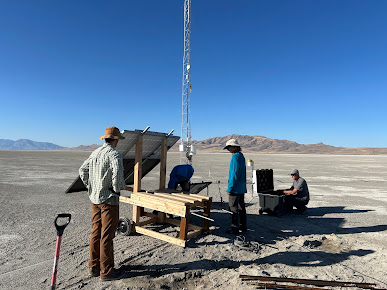The day began at 7am in the William Browning Building on campus. Six people came out for the installation: John Horel, Colin Johnson, Peter Whelan, Kevin Perry, Zac Claerhout, and me. We finished loading John’s truck and embarked on the elaborate journey to the GSL playa. Colin and I drove in the F-150, which was loaded to the gills with equipment. We spent a few hours strapping everything down the day before and going for a joyride to make sure our precious cargo did not fall out. After an hour of Colin’s juicy relationship gossip, we made it to the playa access point west of Syracuse.
 |
| The road leading to the site access point. Taken at 41.05198N, 112.09238W |
We unloaded the trucks, loaded the bikes, and at around 8:30am began the two mile trek across soft gooey ground to the flux site. I was tasked with pulling the tripod for our sensors and various metal pieces for its installment (stakes, shovels). John, Peter, and Colin were stuck with the throne, solar panels, and the CSAT3A pelican case. Zac and Kevin pulled the batteries, tools, the EC-150 pelican case, and their PI-SWERL to test wind erosion on the playa. Who knew that cardio fitness would be a requirement for the Atmospheric Sciences program?
 |
| The bike I used to access the site, with our tripod, stakes, and shovels in tow. John walking ahead and Peter/Colin with the throne in the background |
 |
| Zac and Kevin's PI-SWERL |
Zac, Kevin, and I were roughly half an hour ahead of the throne gang once we arrived at the site, so we made sure to prepare it for installment. We removed the old solar panels to make room for the throne and tower, which were to be placed roughly 30m northeast of the existing tower. Sebastian Hoch did a great job of securing the old solar panels to the ground, so this was a non-trivial task. Once the others arrived, Colin and Peter began the throne installation.
The forecast called for mid to upper 80s, so we had to move quickly, as the highly reflective playa surface and lack of shade amplified the heat. The tasks involved installing the tower for the sensors, mounting the sensors, EC100, and datalogger box on the tower, wiring the sensors to the datalogger, connecting the solar panels to the tower via a ground wire, and securing all equipment to the ground. Colin and Peter were the masterminds behind the throne and solar panels, so they worked on those tasks. John and I were in charge of the tower and sensors.
 |
| Zac, Colin, Peter, and Kevin with the throne and old tower in the background |
The whole installation took roughly 3.5 hours. Peter dug a little trench between the throne and tower for the ground wire, John and I spent some time aligning and levelling the sensors, then I wired the sensors to the datalogger and EC100 box. After securing the guy wires to the towers and fastening the legs of the tripod to the ground with stakes, we were just about finished. We waited for the sensors to report data in order to verify that they were working, loaded up our tools, shovels, and extra stakes, and began the return trek. The chain on my bike broke less than a mile in, so I had to walk the bike the rest of the way back to the truck. We loaded up the trucks and left the site around 1:30pm.
From top to bottom: tower looking northwest, northeast, southeast, and southwest






.jpg)
.png)




.jpg)


